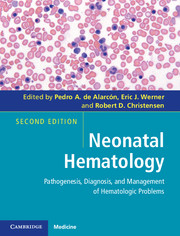Book contents
- Frontmatter
- Contents
- Contributors
- Foreword
- Preface
- 1 A historical review
- Section I Developmental hematology
- Section II Erythrocyte disorders
- Section III Platelet disorders
- Section IV Leukocyte disorders
- Section V Immunologic disorders
- Section VI Hemostatic disorders
- Section VII Transfusional medicine
- Section VIII Miscellaneous
- 20 Disorders of the feto-maternal unit
- 21 Neonatal oncology
- 22 Reference ranges in neonatal hematology
- Index
- Plate section
- References
22 - Reference ranges in neonatal hematology
from Section VIII - Miscellaneous
Published online by Cambridge University Press: 05 February 2013
- Frontmatter
- Contents
- Contributors
- Foreword
- Preface
- 1 A historical review
- Section I Developmental hematology
- Section II Erythrocyte disorders
- Section III Platelet disorders
- Section IV Leukocyte disorders
- Section V Immunologic disorders
- Section VI Hemostatic disorders
- Section VII Transfusional medicine
- Section VIII Miscellaneous
- 20 Disorders of the feto-maternal unit
- 21 Neonatal oncology
- 22 Reference ranges in neonatal hematology
- Index
- Plate section
- References
Summary
The reference range concept
“Normal ranges” for hematologic values of neonates are generally not available. This is because blood is not drawn on healthy normal neonates to establish such ranges, as is done with the consent of healthy adult volunteers. Instead, neonatal hematology generally utilizes “reference ranges.” These ranges consist of 5th to 95th percentile values compiled from laboratory tests that were performed on neonates thought to have minimal pathology relevant to the laboratory test, or with pathology unlikely to significantly affect the test results. The premise on which the reference range concept is based is that these values approximate normal ranges, although they were admittedly obtained for a clinical reason and not from healthy volunteers.
Defining reference ranges in neonatal hematology is complicated by the fact that ranges obtained from term infants generally do not apply to preterm infants, and ranges obtained from low birthweight preterm infants can be very different from ranges obtained from extremely low birthweight infants. As an example, a venous hematocrit of 38% would be within the reference range for a 2-hour-old neonate born at 24 weeks’ gestation, but would be low for a term infant.
Another problem encountered in defining reference ranges in neonatal hematology is that unstable, sick neonates might have values within the reference range, yet those values might not be optimal for patient care. As an example, for a neonate born at 24 weeks’ gestation, now four weeks old, a venous hematocrit of 24% would be within the reference range. However, if such a patient develops a nosocomial infection, becomes hypoxemic and tachycardic, and is placed on a ventilator, the hematocrit of 24% might be too low for optimal patient care. A higher hematocrit might facilitate better tissue oxygenation, diminish the heart rate, and permit better caloric utilization for growth. Therefore, just because a value falls within the reference range does not assure that it is optimal for the clinical circumstance.
- Type
- Chapter
- Information
- Neonatal HematologyPathogenesis, Diagnosis, and Management of Hematologic Problems, pp. 385 - 408Publisher: Cambridge University PressPrint publication year: 2013
References
- 4
- Cited by



